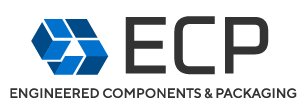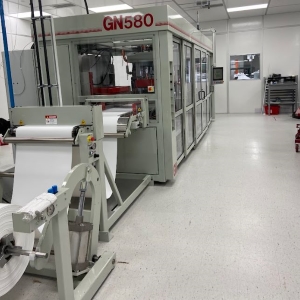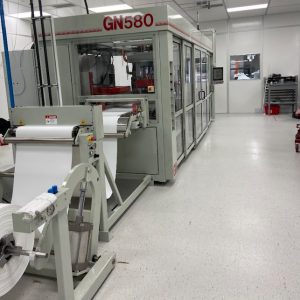Medical Trays & Cleanrooms
Navigating the world of medical packaging can be tricky. Cleanroom levels, material type, and design features are all significant considerations.
CLEANROOM LEVELS:
Matching the level of cleanroom protection with the application is not always easy. An environmentally controlled room for thermoforming is the starting point. This is not a 3rd party rated option but better controls FOD or foreign object debris, allows for double bagging eliminating corrugated dust, and can include hairnets and gloves for operators. The level beyond this is a fairly common level for thermoform packaging trays, blisters, and clamshells is an ISO Class 8 cleanroom. This level corresponds to 100,000 particles per cubic meter. A less common, but still available level is a ISO Class 7 (10,000 particles per cubic meter) cleanroom.
Ultimately, the level of cleanliness is dependent on the application. Even applications of similar products can vary depending on how the part is cleaned, sterilized, and the specifics of the end use. SEE ECP Cleanroom options HERE!
MEDICAL MATERIAL TYPES IN THERMOFORMING:
Materials used in medical trays and clamshells are also critical. Medical-grade thermoplastics like PETG, HDPE, and PP offer excellent properties as shown below:
- Impact resistance: Withstanding bumps and jostles during transit, safeguarding delicate contents.
- Chemical resistance: Impervious to disinfectants and cleaning solutions, maintaining hygiene throughout the chain of custody.
- Transparency options: Clear or translucent styles offer visibility for inventory checks and product identification.
- Sterilization compatibility: Certain materials can withstand sterilization techniques, further protecting against contamination. Typical sterilization methods include gamma irradiation, ethylene oxide (EtO), and steam sterilization. This is a significant factor in choosing the proper material.
DESIGN FOR MEDICAL THERMOFORMING:
The advantages of thermoforming go far beyond cleanroom compatibility. Design allows for a durable, impact-resistant construction that protects delicate medical devices from bumps and bruises during shipping and storage. Secure closures prevent accidental opening and maintain a sterile environment. Customizable designs accommodate a wide range of product shapes and sizes, while clear or labeled lids allow for easy identification and inspection. Additionally, trays can be nestable and stackable, maximizing space efficiency and minimizing storage footprint. Ref. DESIGN GUIDE
Some other design considerations:
- Labeling. The company logo or name can be molded into the product.
- Locking or snap mechanisms
- Finger or tweezer access – how is the part removed from the tray.
- Stack method – should it have load on no load on the part.
- Robotics if applicable and requirements.
One key design consideration and an advantage of thermoformed trays is the ability to customize the compartment to match the part protecting sensitive areas. It allows features to securely hold specific instruments, preventing damage or movement during transit. Types of thermoform packaging include:
Thermoform Clamshells: Ideal for individual items or small sets, providing secure closure and tamper evidence. Perfect for implants, vials, or disposable medical tools. A tray and cover clamshell also has a level of protection from the environment.
Trays: Accommodate multiple items of varying sizes, offering easy organization and compartmentalization. Great for surgical kits, instrument sets, or larger medical devices. A thermoform tray allows for EVOH lamination to PETG, foil lidding, and Tyvek lidding. Considerations include MVTR or Moisture Vapor Transmission Rate.
MEDICAL APPLICATIONS:
- Surgical kit organization: Keeping instruments neatly organized and protected during transport to the operating room.
- Medical device protection: Safeguarding delicate medical devices from damage during shipping and storage.
Pharmaceutical packaging: Providing secure and hygienic containment for vials, syringes, and other medication forms.
Specimen transport: Ensuring safe and controlled transfer of biological samples for laboratory analysis.
In conclusion, packaging solutions go beyond mere protection, safeguarding product integrity and sterility. While cleanroom facilities are the gold standard for some items, a vast majority of medical goods require protection under less stringent conditions. Time spent reviewing the application and requirements is a key component of tray and clamshell packaging development.
RELATED ITEMS:
Standard Cleanroom Hinged Plastic Boxes
INTERESTED IN OFF THE SHELF MEDICAL TRAYS?
Chris Spiegel – cespiegel@ecpplastictrays.com


